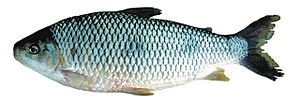Megaleporinus obtusidens facts for kids
Quick facts for kids Megaleporinus obtusidens |
|
|---|---|
 |
|
| Conservation status | |
| Scientific classification | |
| Synonyms | |
|
The boga (scientific name: Megaleporinus obtusidens) is a type of fish found in South America. It's known as a "headstander" because of how it often swims with its head pointing downwards. This fish lives in big river systems like the Paraná River and the Río de la Plata. You can also find it in the Uruguay River and the São Francisco River. It likes to hide among stones and plants in the water.
Contents
What is the Boga?
The boga is a popular fish in South America. In Argentina and Uruguay, people call it boga. Sometimes they use the bigger name bogón. In Brazil, it's known as piapara or piava. Another name for it is tres puntos, which means "three dots" in Spanish. This name comes from the three dark spots on its body.
Where the Boga Lives
This fish lives in many rivers and their smaller branches. It can be found in big rivers like the Bermejo, Pilcomayo, and Juramento. It also lives in lakes and lagoons. The boga often stays near the main parts of rivers. It likes places where it can find shelter. This shelter is usually among stones or thick water plants.
What Does the Boga Look Like?
The boga has a long, wide body. Its head is quite small. It has a blunt mouth, which means it's not pointy. Its teeth are special, like the front teeth of a hare or rabbit. This is why its scientific name, leporinus, means "hare-like".
The fish is usually a light greenish-gray color. It has three round, dark spots along its side. Sometimes these spots are hard to see. Young boga fish have eight wide stripes going down their bodies. These stripes join together at the back. The back of the fish is darker than its belly. This helps it blend in with its surroundings.
How Big Does the Boga Get?
The size and weight of boga fish can be very different. This depends on where they live. It also depends on what they eat and how much food is available. In the Río de la Plata, boga usually weigh about 2 kilograms (about 4.4 pounds). Some can weigh up to 4 kg (about 8.8 pounds). In the upper Paraná River, they can be around 4.5 kg (about 9.9 pounds). Even bigger ones, over 6 kg (about 13 pounds), are found in the middle Paraná River. Some very large ones can even be over 8 kg (about 17.6 pounds)! Adult boga are usually between 40 and 80 centimeters (about 16 to 31 inches) long. Very large fish might actually be other types of Leporinus fish.
What the Boga Eats
The boga is an omnivore. This means it eats both plants and animals. It likes to eat water plants, crabs, and river snails. But its favorite foods are grains and seeds, like wheat and maize. You can often find large groups of boga near ports. This is because cargo ships sometimes drop grains into the water there.
Predators and Reproduction
Boga fish are eaten by bigger fish. Some of their predators include the surubí and the dorado. The boga prefers warm waters. It starts to reproduce when it is about 2 years old. They lay their eggs in the spring and summer months.
See also
 In Spanish: Boga común para niños
In Spanish: Boga común para niños


